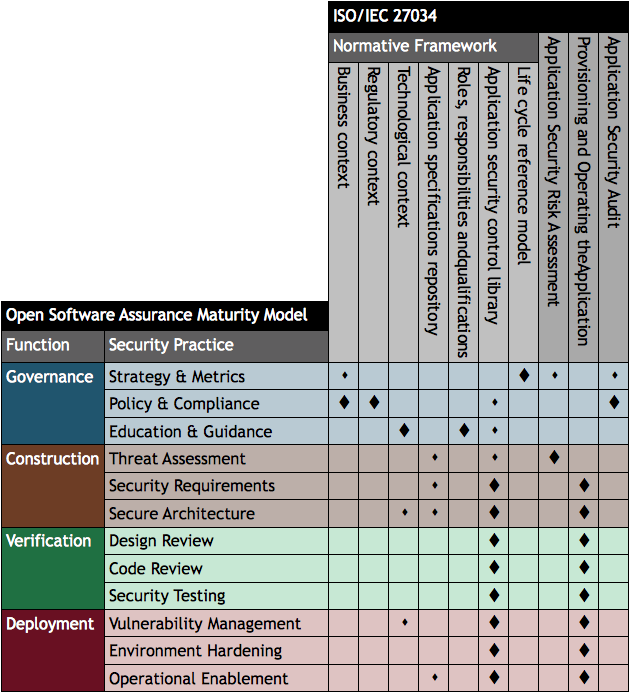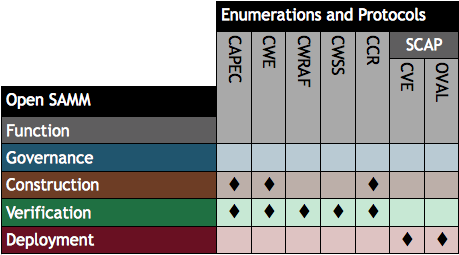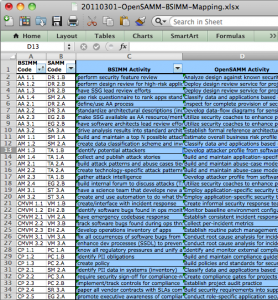Posts Tagged mapping
Mapping SAMM to ISO/IEC 27034
Posted by Colin Watson in Discussion on April 7th, 2012
ISO/IEC 27034 (Application Security), which can be purchased from International Organization for Standardization (ISO) and national standards bodies, is designed to help organisations build security throughout the life cycle of applications.
There is a preview of the contents and first few pages of Part 1 on the IEC website. Part 1 presents an overview of application security and introduces definitions, concepts, principles and processes involved in application security.
The contents listing for Annex A of ISO/IEC 27034:2011 Part 1 mentions a mapping to the Microsoft Security Development Lifecycle (SDL), and in the section describing the standard’s purpose, it refers to the need to map existing software development processes to ISO/IEC 27034:
Annex A (informative) provides an example illustrating how an existing software development process can be mapped to some of the components and processes of ISO/IEC 27034. Generally speaking, an organization using any development life cycle should perform a mapping such as the one described in Annex A, and add whatever missing components or processes are needed for compliance with ISO/IEC 27034.
The contents for Part 1 shows the SDL is compared with an Organization Normative Framework (ONF) made up from ideal application security related processes and resources:
- Business context
- Regulatory context
- Application specifications repository
- Technological context
- Roles, responsibilities and qualifications
- Organisation application security control (ASC) library
- Application security life cycle reference model
This is very useful but I wondered how a comparison with Open SAMM might look. I have therefore created the table below indicating how the processes and resources mapped to SDL relate to the 12 security practices defined in Open SAMM. The large diamond symbol is used to indicated where an Open SAMM practice has a very close relationship with a topic within ISO/IEC 27034 and a smaller diamond for weaker relationships.

The ISO/IEC 27034 “life cycle reference model” appears to be most closely aligned with the idea of an organisation-specific “software assurance programme” in SAMM combined with a risk-based approach to applying security to different applications, and within sub-parts of application systems.
We can also see the SAMM construction, verification and deployment practices primarily relate to the ISO/IEC 27034 application security control library used for the overall organisation and individual applications, as well as the actual use of the framework during acquisition/development, deployment and operation of (provisioning and operating) the application.
SAMM is available to download free of charge, and can also be purchased at-cost as a colour soft cover book.
Mapping SAMM to Security Automation
Posted by Colin Watson in Discussion on March 25th, 2012
The presentation by Richard Struse (US Department of Homeland Security) and Steve Christey (Mitre) of Risk Analysis and Measurement with CWRAF (PDF) at the IT Security Automation Conference in October 2011 illustrates how software security automation enumerations and protocols map to SAMM’s construction, verification and deployment security practices. The specifications highlighted in the presentation’s final slide are:
- Common Attack Pattern Enumeration and Classification (CAPEC)
- Common Weakness Enumeration (CWE)
- Common Weakness Risk Analysis Framework (CWRAF)
- Common Weakness Scoring System (CWSS)
- CWE Coverage Claims Representation (CCR)
- Security Content Automation Protocol (SCAP)
I have summarised the slide in the table below.

For further security registries, description languages and standardised processes see the Making Security Measurable website. Risk Analysis and Measurement with CWRAF is being presented at AppSec DC 2012 in April.
BSIMM activities mapped to SAMM
Posted by Pravir Chandra in Changes, Discussion on March 3rd, 2011
 For the impatient, click here to download the mapping spreadsheet. For those still reading… Firstly, many thanks to the OWASP community for hosting the fantastic OWASP Summit 2011 in Lisbon, Portugal a few weeks back. This was a fantastic forum for us to hold OpenSAMM working sessions to discuss experiences and potential improvements to the model. Over the course of the week, we were able to build up a list of additions/changes we’d like to make in the next release, but I’ll cover those in more detail under separate cover.
For the impatient, click here to download the mapping spreadsheet. For those still reading… Firstly, many thanks to the OWASP community for hosting the fantastic OWASP Summit 2011 in Lisbon, Portugal a few weeks back. This was a fantastic forum for us to hold OpenSAMM working sessions to discuss experiences and potential improvements to the model. Over the course of the week, we were able to build up a list of additions/changes we’d like to make in the next release, but I’ll cover those in more detail under separate cover.
The main thing I want to share now is an activity-level mapping of the ~110 BSIMM2 activities to the corresponding 72 activities in SAMM. Obviously, this means that in some cases, more than one BSIMM activity may be mapped to a single SAMM activity. That being said, the overlap spots seem to make sense when we (the ~10 people that worked on it) looked at them in detail. Don’t take our word for it, though, please do review and send any feedback (mailing list or just comment below). And before you ask, yes, you probably will have to go read the respective BSIMM and SAMM activity descriptions in order to see the linkage for some of them (given the occasionally imprecise nature of written language, it’s not always obvious from the activity names alone).
It’s worth noting that we did leave two BSIMM activities unmapped. They are SM 3.2 “run external marketing program” and T 3.3 “host external software security events”. Based on the experience of the working group participants, these activities did not appear to directly improve an organization’s software assurance posture, rather, they appeared to be evidence that the organization was using its (presumably mature) software assurance posture to bolster its public perception or generate additional value in the business. Again, this is totally up for debate if anyone has an argument the other way, so please do share your thoughts.
Last, but certainly not least, I’d like to thank all the people at the Summit for the detailed and thoughtful conversations about using SAMM and about what we can do to make it even better. Specifically, those that contributed and helped review this mapping (in no particular order):
- Colin Watson
- Seba Deleersnyder
- Steven van der Baan
- Bart De Win
- Justin Clarke
- Dan Cornell
- Sherif Koussa
- Brian Chess

